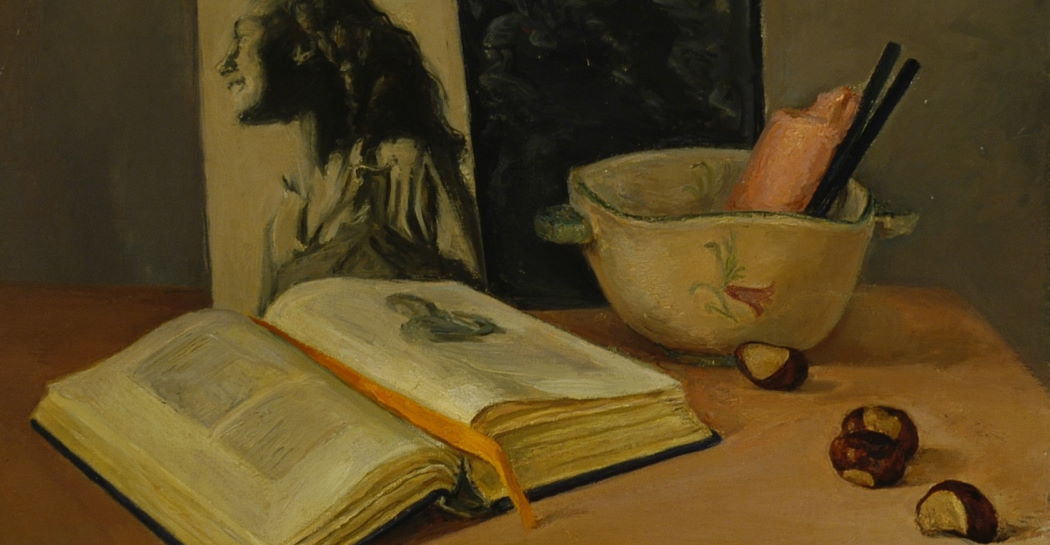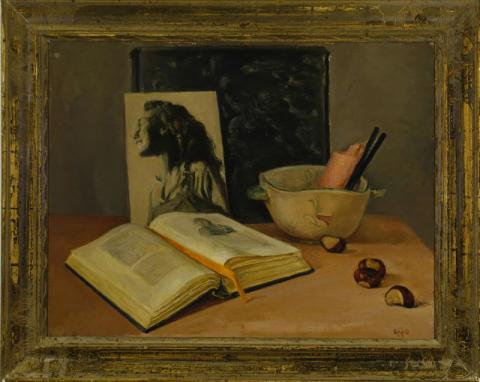The Artwork of the Month of the Roman School Museum - November 2022
Cipriano Efisio Oppo (Roma, 1891 – Roma, 1962)
Le castagne, 1942
Oil on canvas, 50x65 cm
On loan Fondazione Archivio C.E. Oppo

In this still life, the artist has succeeded in conveying an atmosphere vibrant with melancholy and intimacy. On a flat surface with uniform, warm tones are placed, in random order, a book, four chestnuts and a large ceramic bowl with handles, inside of which are some objects. In the background of the composition, a black and white photograph, resting vertically against a dark plane, depicts a young woman in a half-length position, her beautiful smiling face turned in profile to the left. Compared to the dark and intimate interior setting, the photograph projects us into an imaginary outdoor world to which the girl's illuminated gaze is directed. The autumn season, to which the chestnuts and the soft lighting of the environment allude, are contrasted, in a kind of visual and conceptual oxymoron, with the youthful season and the vitality of the portrayed subject. The open book, in which the orange ribbon between the pages marks the point of an interrupted reading, creates a sense of suspension of time. The composition as a whole is evocative of a context and a narrative that goes beyond the objects depicted: the calm and collected family atmosphere, presences and voices both near and far, stories whose transience in the scenario of life is affirmed by the very theme of 'still life'.
In the early 1940s, Oppo produced a series of works with the theme of 'still life', paintings in which he placed objects, photographs and books that testify to his desire to rediscover the intimacy of family life preserved, during the difficult years of the war, in the villa in San Michele di Moriano (Lucca), a residence purchased to make his loved ones feel safer. During this period, he wrote letters to his friend, the painter Mario Broglio, which testify to a psychological condition charged with distrust, but comforted by affection. The girl in the photograph included in this painting is his daughter Eugenia, portrayed by Oppo on several occasions in a series of shots.
CIPRIANO EFISIO OPPO (Rome, 1891 - Rome, 1962)
He was a versatile and multifaceted personality, who added to his commitment as a painter, draughtsman, set designer, art critic and film-maker, in the inter-war period, the no less engaging role of artist promoter and organiser of visual arts exhibitions of great relevance; suffice it to mention the artistic direction of the Quadriennale d'Arte at the Palazzo delle Esposizioni in Rome, which he conceived and conducted from the first edition in 1931 until the one in 1943.
His activity as a cultural promoter did not prevent him from pursuing a career as a painter, which he started by participating in important national exhibitions such as the Venice Biennale in 1926. During his years of public engagement, however, he preferred to exhibit abroad, in order to avoid conflicts of interest, participating in numerous activities and exhibitions. His experiences in the USA were varied: in 1931 he was a member of the jury of the Carnegie Prize in Pittsburgh; in the same decade he took part in An Exhibition of Contemporary Italian Painting at the Baltimore Museum and in the World's Fair in New York. He also exhibited at the Jeu de Paume in Paris in 1935. Although he was a party man - his membership at the Fascism, where he also occupied the position of Deputy of the Camera dei Deputati, is well known - he pursued his activity as a promoter of the arts with true passion in the identification of talents that represented the various artistic tendencies present in the area. In a speech to the Chamber of Deputies, he emphasised that 'the problem of art is also a political problem like that of science and like all the fruits of the intellect and culture in general', thus affirming the need for art and culture to live independently of political life.
From an artistic point of view, Cipriano Efisio Oppo was initially influenced by the international symbolist climate and Italian pointillism, passing through a fauve style of painting and finally arriving at the affirmation of a pictorial style with fast and direct brushstrokes in the representation of family life, and a mature mastery of tonal painting. His activity as a set designer for the Reale Teatro dell'Opera Roma, the Maggio Musicale Fiorentino and La Scala in Milano was also intense. He also realised fresco works, with Sironi and Santagata, at the Casa Madre dei Mutilati in Rome and, alone, in the Cattedrale di Pomezia.
Having joined the Repubblica Sociale Italiana, but without holding any political office, he was arrested in Venice, where he was teaching, in April 1945. On that occasion he was recognised by his former student at the Accademia di Belle Arti, Afro Basaldella, deputy commander of a partisan brigade, who took him to safety in Rome. After the war, he was free to exhibit at the Quadriennale as an artist in the 5th and 6th editions, in 1948 and 1951. In 1960, he was appointed Accademico di San Luca.
Back to the section > The Artwork of the Month of the Roman School Museum












































